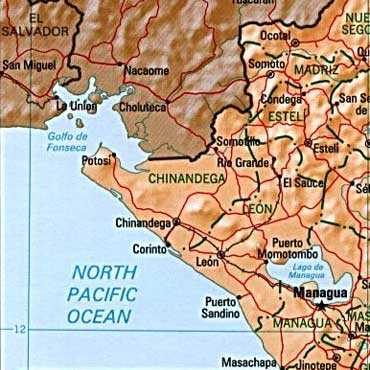The Fonseca Gulf or the ‘Golfo de Fonseca’ is located on the Pacific Ocean of Central America.
It is an inlet of the Pacific Ocean, with a size of 700 sq miles (1,810 sq km) and is shared by El Salvador, Honduras and Nicaragua. Situated in a volcanic area, it is a natural shallow harbor shared by the three countries. It receives the Choluteca River, among others. La Unión, in El Salvador, and Henecán, in Honduras, are the chief ports. Three Islands are found in the ‘Gulfo de Fonseca’. ‘Isla el Tigre’ is an Island entirely owned by Honduras. A neighboring larger island is co-owned with El Salvador.
 |
 |
On July 30, 1502, during his fourth and last trip through the Americas, Christopher Columbus reached the Bay Islands of Honduras and soon afterwards the coast of the mainland. This was the first time he saw Honduran soil. It is said that Columbus, while exploring the eastern coasts of the region, reached a cape where he found shelter from the inclemency’s of a tropical storm and declared, Gracias a Dios que hemos salido de estas honduras! [Thank God we’ve escaped these treacherous depths!]. According to many historians, as a result of this exclamation the cape became known as Gracias a Dios and the territory as Honduras. Gil González de Ávila, a Spanish explorer, discovered the Gulf later in 1522. It is not known how the Gulf came to be named as Fonseca. The name Fonseca was in use in both Portugal and Spain.
The coastal area is rich in biodiversity containing vast mangroves, beautiful estuaries and natural lagoons. Various species of mangrove form the predominant vegetation in this area of typical marine-coastal ecosystem influenced by the fluctuation of the tides. Several lagoons in the rainy season provide refuge for both migratory and non-migratory birds, as well as spawning grounds for various species of tortoise, molluscs, crustaceans, and fish.
The area is important to the nearby people for its mangrove wood for construction as well as for traditional fishing and grazing activities. However the delicate eco system of the Gulf is under increasing threats from the vast scale exploitation of the lands for Shrimp farming and other industrial activities.
Leading the struggle to save the eco system of the Fonseca Gulf is the Committee for the Defense and Sustainable Development of the Flora and Fauna of the Fonseca Gulf (CODDEFFAGOLF), a non-governmental grass-roots organization. Its mission is the defense of the natural resources of the coastal zone of the Fonseca Gulf and the sustainable development of the rural communities in the area. As a result, it seeks economic growth for the rural inhabitants in the area of the Gulf of Fonseca based on social and environmental considerations.
CODDEFFAGOLF’s international impact is seen even in Sri Lanka. In its support of the struggles of local communities against the uncontrolled and damaging expansion of shrimp aquaculture, it has helped communities in Sri Lanka (Bangladesh, Mexico and Guatemala, among others) with forums and workshops provided to national and local officials, as well as to the general public.
Reference:
CODDEFFAGOLF’s Web Site
http://morazan.tripod.com/cgolf